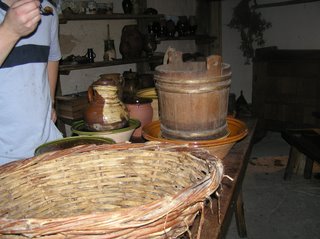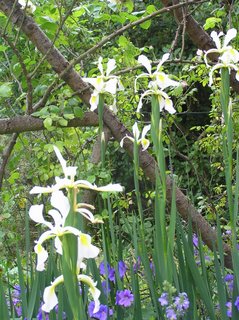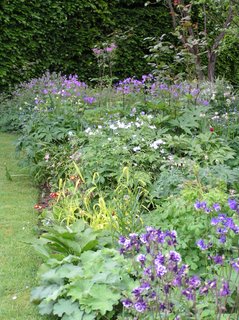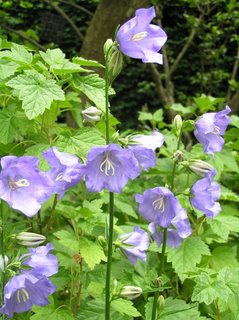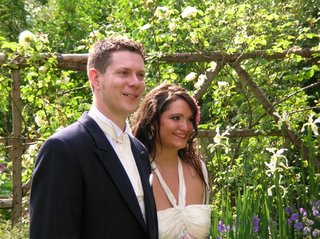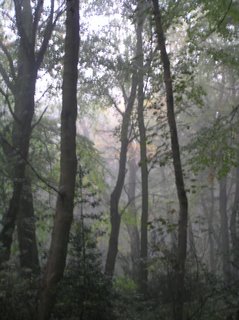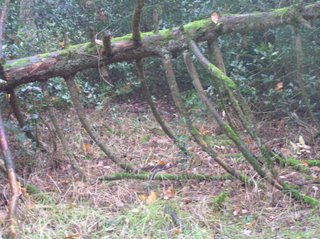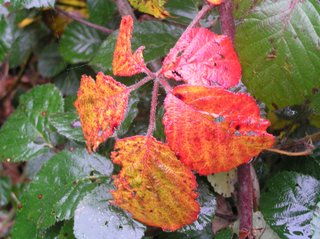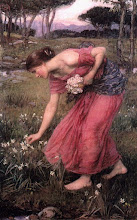
It is the Celtic New Year tonight - so I wish those of you who walk my path a very Happy Samhain! To those who don't I wish you a happy and fun Halloween.










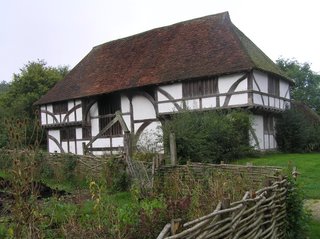
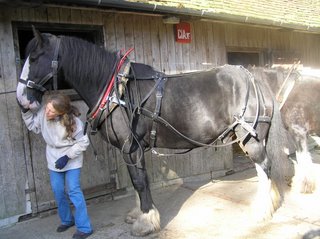 This is Neville, one of the Shire horses who live and work at the museum. They are used for ploughing, carting, haymaking and all the other farm tasks that they would have done when horses were used for everything. The museum also has a pair of oxen which are used as well but they weren't around to be photographed while I was there. I love all the big working horses and Neville is particularly patient and friendly.
This is Neville, one of the Shire horses who live and work at the museum. They are used for ploughing, carting, haymaking and all the other farm tasks that they would have done when horses were used for everything. The museum also has a pair of oxen which are used as well but they weren't around to be photographed while I was there. I love all the big working horses and Neville is particularly patient and friendly.  This is one of the Southdown sheep, this breed is native to the Sussex Downland country and produces very fine meat and wool, they are also very attractive and friendly, this one was very keen to speak to me!
This is one of the Southdown sheep, this breed is native to the Sussex Downland country and produces very fine meat and wool, they are also very attractive and friendly, this one was very keen to speak to me! The calf is a Sussex and again a native breed to this county. They were originally used as plough oxen rather than for meat only being slaughtered when they were too old for work. A full grown animal is very powerful but when young they are simply pretty and very shy.
The calf is a Sussex and again a native breed to this county. They were originally used as plough oxen rather than for meat only being slaughtered when they were too old for work. A full grown animal is very powerful but when young they are simply pretty and very shy.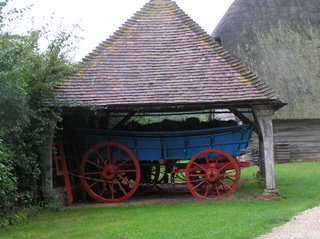 This is an 18th century waggon shed, I absolutely love these old farm waggons, I find the curved line so pleasing to my eye and I could stand and just look at them for hours.
This is an 18th century waggon shed, I absolutely love these old farm waggons, I find the curved line so pleasing to my eye and I could stand and just look at them for hours.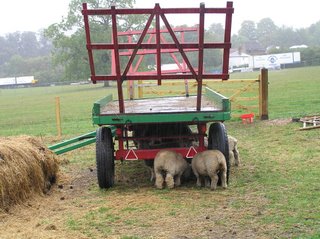 Southdown sheep sheltering from the rain under another of the lovely old pieces of farm equipment. It was pouring down at this point.
Southdown sheep sheltering from the rain under another of the lovely old pieces of farm equipment. It was pouring down at this point. Walderton, a 17th century brick and flint cottage with medieval origins.
Walderton, a 17th century brick and flint cottage with medieval origins.  Boarhunt is a 15th century hall house ie one large central hall open to the ceiling with a couple of bays at each side,one an inner room and the other used for storage. The hall would have had a fire in the centre which would have been used for both heat and cooking. No chimney, the smoke made its way out through the windows and the roof. Pretty to look at, pretty uncomfortable to live in I should think!
Boarhunt is a 15th century hall house ie one large central hall open to the ceiling with a couple of bays at each side,one an inner room and the other used for storage. The hall would have had a fire in the centre which would have been used for both heat and cooking. No chimney, the smoke made its way out through the windows and the roof. Pretty to look at, pretty uncomfortable to live in I should think! This is a lovely wild flower that you see everywhere in this part of England, it's a type of wild clematis with lovely country names the most common of which are old man's beard and traveller's joy. It was so beautiful I had to have a photograph of it.
This is a lovely wild flower that you see everywhere in this part of England, it's a type of wild clematis with lovely country names the most common of which are old man's beard and traveller's joy. It was so beautiful I had to have a photograph of it. Back at the stables - Neville and friend again.
Back at the stables - Neville and friend again.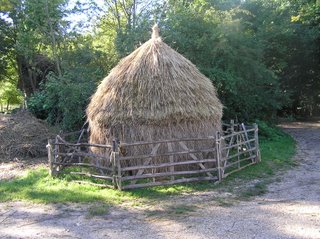 Another nostalgia trip for me - a small haystack, something you never see in this coutry any more and so much more attractive to look at than a field full of black plastic rolls. They do still have them in Romania, I saw them in the Carpathians when I was there, it was like stepping back a hundred years, the hay was cut by men using scythes and little old ladies dressed in black were raking it up with wooden hay rakes. However I digress!
Another nostalgia trip for me - a small haystack, something you never see in this coutry any more and so much more attractive to look at than a field full of black plastic rolls. They do still have them in Romania, I saw them in the Carpathians when I was there, it was like stepping back a hundred years, the hay was cut by men using scythes and little old ladies dressed in black were raking it up with wooden hay rakes. However I digress!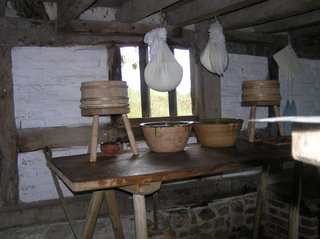 This is the dairy in Pendean cottage, the volunteers had been making cheese and it is hanging up to drip overnight seperating the curds and the whey.I'm hoping to do a dairying day course next summer, the idea of buttermaking especially appeals to me.
This is the dairy in Pendean cottage, the volunteers had been making cheese and it is hanging up to drip overnight seperating the curds and the whey.I'm hoping to do a dairying day course next summer, the idea of buttermaking especially appeals to me. A Tamnworth boar, the old cottagers pig. They are my favourite breed mostly because I love the rich chestnut colour. Alas, this particular one is no more, all that remains is a selection of bacon, hams and sausages!There are other Tamworths at the Museum who will make it through the winter though.
A Tamnworth boar, the old cottagers pig. They are my favourite breed mostly because I love the rich chestnut colour. Alas, this particular one is no more, all that remains is a selection of bacon, hams and sausages!There are other Tamworths at the Museum who will make it through the winter though. This is a granary from the early 1700s, I love this building, the lovely mellow colour of the bricks, the thatched roof, the staddle stones that support it - there is something totally satisfying about the whole thing.
This is a granary from the early 1700s, I love this building, the lovely mellow colour of the bricks, the thatched roof, the staddle stones that support it - there is something totally satisfying about the whole thing. This is a walking wheel that stands in one of the bedrooms in Bayleaf. It must have been tiring work to spin on this. I'm not a spinner so I don't know exactly how it is used but the name indicates considerable input of energy! Even though it is displayed upstairs I imagine it would really have been kept in the living area downstairs so that the lady of the house could spin whenever she had some spare time while waiting for food to cook etc.
This is a walking wheel that stands in one of the bedrooms in Bayleaf. It must have been tiring work to spin on this. I'm not a spinner so I don't know exactly how it is used but the name indicates considerable input of energy! Even though it is displayed upstairs I imagine it would really have been kept in the living area downstairs so that the lady of the house could spin whenever she had some spare time while waiting for food to cook etc.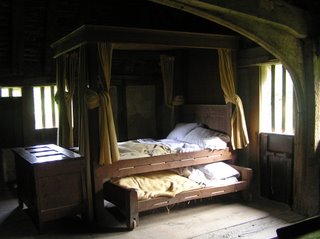 This is the same room showing the truckle bed and a storage chest where clothes would have been kept. The bed had mum and dad in the main bed and assorted children in the pull out truckle.
This is the same room showing the truckle bed and a storage chest where clothes would have been kept. The bed had mum and dad in the main bed and assorted children in the pull out truckle. Another view of the medieval garden at Bayleaf. I'd love to have a garden like this.
Another view of the medieval garden at Bayleaf. I'd love to have a garden like this. More representatives of the livestock, these I think are Light Sussex and Dorking hens, both traditional breeds. I like hens, their clucking and sqawking is somehow a very comforting sound. If anyone ever has chance to visit the Weald and Downland Museum it is well worth going, it's interesting for both adults and children and is set in beautiful surroundings. The courses they offer are very wide-ranging and open to anyone who wants to take them. The ones I've done have all been connected with herbs and cookery but there are also crafts, traditional building techniques, learning to plough with heavy horses, bee-keeping and more besides. You can learn to make your own longbow, carve a Green man, do blacksmithing, there are drawing and painting classes - the list is endless.
More representatives of the livestock, these I think are Light Sussex and Dorking hens, both traditional breeds. I like hens, their clucking and sqawking is somehow a very comforting sound. If anyone ever has chance to visit the Weald and Downland Museum it is well worth going, it's interesting for both adults and children and is set in beautiful surroundings. The courses they offer are very wide-ranging and open to anyone who wants to take them. The ones I've done have all been connected with herbs and cookery but there are also crafts, traditional building techniques, learning to plough with heavy horses, bee-keeping and more besides. You can learn to make your own longbow, carve a Green man, do blacksmithing, there are drawing and painting classes - the list is endless.

 and stalks. We had to prepare our spiced vinegar, deciding which spices we would use then putting it in the fire to boil up while we peeled the shallots. No measuring jugs of course so we had to decide by eye how much vinegar we would need - we got it wrong first time and had to prepare a second lot as well! By the way, when I say we put the pot of vinegar IN the fire to boil I do mean that quite literally, it isn't a typing error! These are my finished pickled shallots.
and stalks. We had to prepare our spiced vinegar, deciding which spices we would use then putting it in the fire to boil up while we peeled the shallots. No measuring jugs of course so we had to decide by eye how much vinegar we would need - we got it wrong first time and had to prepare a second lot as well! By the way, when I say we put the pot of vinegar IN the fire to boil I do mean that quite literally, it isn't a typing error! These are my finished pickled shallots.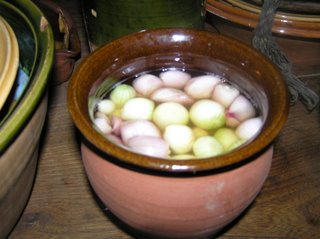


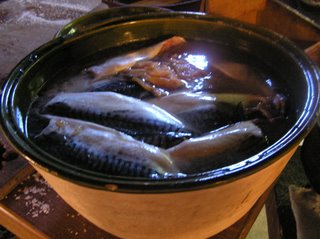
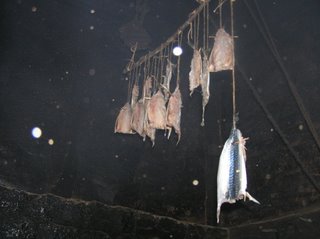
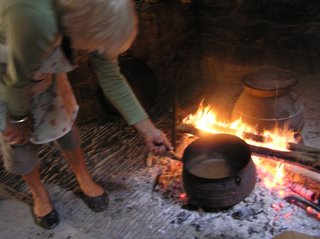 This is all done by eye of course - no measuring jugs in those days. This never actually got finished because of the time element but would have been boiled up again next day and finished by whoever was volunteering in the Tudor kitchen. When it's ready it is ladled out out onto boards and spread and left to cool.Then it is turned regularly over a period of time until sugar crystals form.Then it can be stored for up to 3 or 4 years or eaten straight away. It's a luxury item of course, only a rich household would be able to afford the sugar to make it and it would be kept for high days and holidays. As a matter of fact I've made this before on another course using damsons and the end result is very good.
This is all done by eye of course - no measuring jugs in those days. This never actually got finished because of the time element but would have been boiled up again next day and finished by whoever was volunteering in the Tudor kitchen. When it's ready it is ladled out out onto boards and spread and left to cool.Then it is turned regularly over a period of time until sugar crystals form.Then it can be stored for up to 3 or 4 years or eaten straight away. It's a luxury item of course, only a rich household would be able to afford the sugar to make it and it would be kept for high days and holidays. As a matter of fact I've made this before on another course using damsons and the end result is very good.